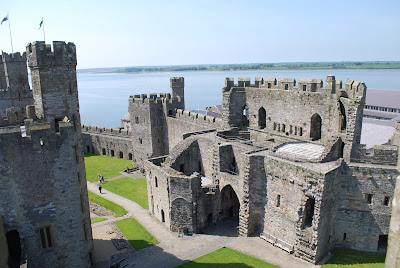Friday, 22 April 2016
Caernarfon Castle
Caernarfon, with its strategic position guarding the south-western entry to the Menai Strait separating Anlesey from the mainland, had been an important base even in Roman times, and later was the centre of the Welsh kingdom of Gwynedd. Its capture by King Edward I in 1283 was the culminating point of his campaign to subdue north Wales, and he paid his viceroy, Otto de Grandson, over £1,000 a year for holding the town and "keeping the land of Wales".
Edward's master castle architect, James of St. George, was summoned to build a suitably splendid and powerful castle in Caernarfon. It provides an immediately unusual appearance to the visitor, in that the towers are polygonal rather than round, and there are bands of pale limestone in the walls.
The castle thus resembles the famous land walls defending Constantinople. King Edward had been on crusade as a prince, and although he never visited Constantinople, it is likely that some of his entourage did, and reported on what they saw.
In its plan, the castle is shaped like an hourglass, with a narrow waist. There is a very elaborate gatehouse, which, however, was built in the early 14th century, after James's death.
The most spectacular part of the castle is the massive south-western Eagle Tower, which has its own watergate.
The three small towers upon it are said to be a reference to the coat of arms of Edward's beloved wife Eleanor of Castile.
On the northern side of the castle, outside the main gate, Edward built a walled town for English settlers,
the Welsh only being permitted to enter on market days; though this did not save the incomplete castle from being stormed by the Welsh in 1294.
The completed castle was so strong that it defied Owain Glyndwr's attempts to capture it at the start of the 15th century. In 1403 it was successfully defended by a garrison of just 28 men!
Everyone knows the story of how in 1284 Edward caused his son, later King Edward II, to be born in Caernarfon, in order that he should keep his promise to the Welsh chieftains to give them "A prince who was born in Wales and does not speak a word of English". In fact, the castle was far from complete at the time, and Queen Eleanor probably had to endure an uncomfortable delivery in a local wooden house. She was 42 at the time, and can hardly have enjoyed the experience very much. It is worth pointing out that the King himself could speak little or no English, the language of the court still being Norman French. The other interesting fact about this episode is that baby Edward was not at this stage the heir to the throne. The King had an older son, called Alfonso, who, however, died four months later in circumstances which remain unknown. Very few people realise that England could have had a King Alfonso!
Many strange tales became attached to the castle. One was that Edward had found a legionary Eagle from the nearby Roman base of Segontium and placed it atop the Eagle Tower. Another said that the builders had uncovered the body of Magnus Maximus, a late-Roman commander in Britain who had tried and failed to make himself Emperor in the 380s, and who figured in Welsh legends. Owain Glyndwr boosted the chances of his rebellion by invoking prophesies of Merlin.
In 1911 the future King Edward VIII was formally invested as Prince of Wales in the castle, and in 1969 the ceremony was repeated for Prince Charles. Charles made a speech in Welsh for the occasion, which would undoubtedly have surprised King Edward I!
Subscribe to:
Post Comments (Atom)







No comments:
Post a Comment